|
|
|
|||
|
|
||||
|
|
||||
| Smoke Trails | ||||
|
|
HOME | SITE MAP | FORUM | CONTACT |
|
||
|
ABOUT | MOTORS | MODELS | ARCHIVE | HISTORY | STORE | FAQ | LINKS
|
|
|
|
|
|
||||||||||||||||||||||||||||||||||||||||||||||||||||||||||||||||||||||||||||||||||||||||||||||||||||||||||||
|
Smoke Trails 4
(May 2006)
by Roger Simmonds Reprinted from SAM 35 Speaks, May 2006 Afterburning First, as a follow up to the recent discussion of the IMA smoke-laying drone, here is a 3-view (right) that first appeared in J R Vanderbeek’s article, ‘Britain’s Wartime “Doodlebug”’, Aircraft Annual, 1957. Notwithstanding the article’s ill-considered title, the defensive Swallow had little in common with the accursed V.1 – except (perhaps) that it was designed to explode after the smoke generator (which apparently provided sufficient thrust to keep it airborne after the cordite rockets had boosted it from its ramp to its flying speed) was exhausted. As to the rest of the article, it is interesting that Vanderbeek, director at FROG, gives due credit to Sydney Hansell, but tells the Swallow’s story without reference to Joe Mansour and Bill Wilmot, or even Neville Shute Norway. The bad feeling between IMA/FROG and its two eminent ex-directors had obviously not dissipated ten years after the split. Fred Steer has based his unique Swallow kit on this 3-view, and readers who wish to deal by postal mail can order one from Pottyproductions, 53C Broughton St, London SW8 3QU. Fred’s cornucopian website is also devoted to dolls’ houses. There is a neat historical resonance here – Joe Mansour was part of the team that built the Queen’s Doll’s House before the War! 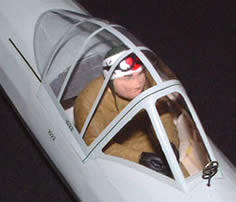
Another Fairey Delta 2 |
 The IMA Swallow (1944). The four cordite rockets each developed 50 lb thrust and its complex flight pattern required a complicated (and quite temperamental) autopilot with a gyroscope driven by compressed air.
- Aircraft Annual, 1957 (p. 80)
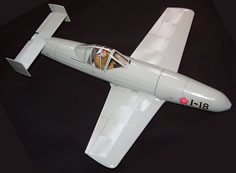 Steve Bage’s unusual kamikaze Ohka for Rapier L.2 and catapult launch. Initially tail heavy and twitchy, it now flies predictably, if somewhat fast
- Steve Bage
|
||||||||||||||||||||||||||||||||||||||||||||||||||||||||||||||||||||||||||||||||||||||||||||||||||||||||||||
|
|
|
|||
|
The more perspicacious readers will have realised that the Fairey Delta 2 is something of an obsession with me. As John Park’s delightful reminiscence last month illustrates, its record-breaking flight in March 1956 made quite an impact on air-minded boys of all ages, facilitated by extensive cover on the TV, wireless and other media of the day. The F.D.2 itself was featured in a 1957 Aeromodeller, and as has been recorded in these articles before, Eagle had a special offer for an attractively coloured cardboard model. FROG brought out a very tasty plastic model. However, only two kits for flying models ever reached the shops. The problem was not so much the prototype’s futuristic shape, as model deltas, both rubber and i/c powered, were not unknown on the flying field, but of finding a realistic means of propulsion. In those days, when model pulsejets were all but banned and miniature turbojets still 25 years in the future, only Jetex and ducted fan (impeller) propulsion was viable. The Jetex Tailored F.D.2 has been discussed in these articles before, and, of course in SAM 35 Yearbook 13, but Veron’s F.D.2 for ducted fan (right) has not been given the attention it deserves. Axial and centrifugal impellers had of course been around for some time, and not a few fanciful articles and models had appeared in Aeromodeller and Model Aircraft by the mid-fifties. Experts like P E Norman and John Coatsworth had some real success with them, but only Phil Smith, the chief designer at Veron (aka Model Aircraft (Bournemouth) Ltd.) was able to produce a practicable commercial product in the ‘Imp’. Prior to the F.D.2, Phil had designed and kitted a Lavochkin 17 and an F-86 Sabre, and with this experience he was able to go all-out to produce a realistic model. The prototype weighed about 14 oz and was powered by one of the lighter and better-performing 1 cc model diesels of the day, the AM 10, which drove a 3¼" impeller at 16,000 rpm. Phil says his own special fuel was needed to achieve this. 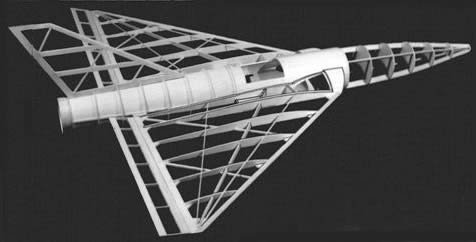 Note the reflexed (non scale) elevons and slight dihedral
(photograph courtesy of Phil Smith)
Note the reflexed (non scale) elevons and slight dihedral
(photograph courtesy of Phil Smith) |
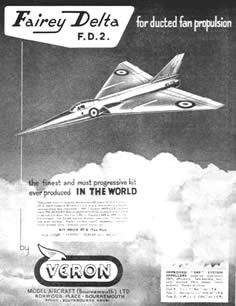
- Model Aircraft, Aug. 1957
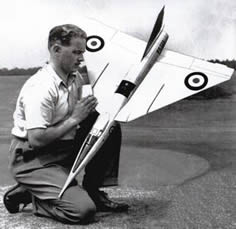 Phil Smith with prototype, Halton Aerodrome, 1957
- Phil Smith
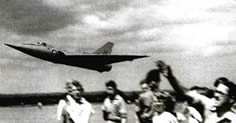 The efficiency of ducted fans depends on sufficient air entering the plenum chamber, and they provide little thrust until they get up to speed: Phil Smith gives the F.D.2 a vigorous ‘heave-ho’ at Halton in 1957. Note the blurring of the spectators in this vintage action shot!
- Phil Smith
|
|||

But fly it did. Model Aircraft in captioning the inflight photo below right said, “This flying scale model heralds one of Veron’s finest achievements in scale jet flight. 38 inches span and 48 inches long, its fascinating needle-nose delta soars overhead with effortless grace propelled by 1.0 or 1.5 cc diesel or glow pug motors”. Hmm … a nice example of mid-fifties bathos! I asked Phil about its performance, and he comments: “The actual thrust of the prototype was not calibrated. It was not very great […] but this did not matter – with all that wing area it was in effect a powered glider.” Though not, perhaps, a particularly profitable one, and Phil had to battle with Veron management to get similar ambitious projects off the ground. Nevertheless, over a hundred of his kits were sold, though it is not known how many were completed and flown successfully. Phil is still selling plans for this unique model, which is eminently suitable for one of the highly engineered and powerful electric ducted fan units now available. There may even be room for micro radio control, and I look forward to seeing at least one on the flying field soon. The foregoing paragraphs do little justice to Phil Smith’s ducted fan models for Veron as a whole, and a more thorough history of these will, it is hoped, appear in the next SAM 35 Yearbook. If any reader has any reminiscences of building and flying these models, I would love to hear from you, so that these can be recorded for posterity. |
|
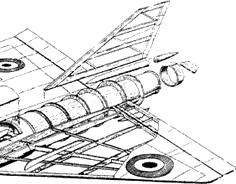 Phil’s neat construction diagram taken from his plan. Construction, though ‘traditional’, is quite complex and not for the faint hearted! The wing has a proper aerofoil and is built up with movable elevons, which are adjusted during trimming. The fuselage is essentially a balsa tube with stringers over formers. With all that area, the model was lightly loaded, but power was limited and tissue covering with a light finish was recommended.
- Phil Smith
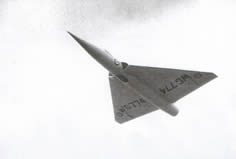 “one of Veron’s finest achievements in scale jet flight […] its fascinating needle-nose delta soars overhead with effortless grace”
- Model Aircraft, Aug. 1957
|
||
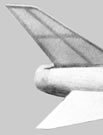
Pierre Claudy, (who unearthed last month’s Aquilon and Super Mystère) has provided more details of his modelling career via John Miller Crawford: “rubber power and sailplanes as well as Jetex, a helicopter, car (FIAT), MiG 15, Planojet, [I haven’t heard of this one] Javelin, Super Mystère, Scorpion, [nor this] Tupolev 104, Lockheed U2 [tricky] and [this was a real thrill] a Nord Griffon II”. Pierre reckons this was about 30 models in all, adding that the Super Mystère was the best flyer, and that he also ‘manufactured’ rockets – causing “lots of explosions”! Pierre concludes his résumé, “Because of my studies, the Griffon was the last one I made. Now that I'm in retirement, I've become young again, and I'm planning to build a radio-controlled Jetex plane, because I haven't yet seen one.” |
|
 The only photo of Pierre Claudy’s Nord Griffon II – note the metal point! Pierre recalls, “Hand launching gave a very fast glide of about 10 metres. That’s why I decided to install a Jetex 100 instead of a 50, which was my original intention. Flying with the Jetex motor produced a rapid climb, and a fast descent. The third landing was fatal for my beautiful Griffon”
- Pierre Claudy (retouched JMC)
|
||
|
A Nord Griffon II for Cox Pee Wee .02 appeared in the Smoky Addiction for February 2005, and I have been toying with a Rapier powered version of this extraordinary prototype for a couple of years now, even going so far as drawing up a rudimentary plan and building a fuselage to see how everything would go together. This didn’t work out too well and I put it on the back burner to await inspiration. Thinking Pierre’s model might provide this, I wondered if he still had his plan. Finding it was no easy task after so many years, but Pierre persisted, writing, “Taking my courage in both hands I plunged through the strata of my old papers. With a third hand, I took hold of the remains of the plan […] with a fourth, I scanned it!” I’m afraid something of Pierre’s idiomatic Gallic humour has been lost in translation, but the results of his Shiva-like efforts are well worth it — a genuine period Griffon II for Jetex 100. |
|
|||
 | ||||
|
|
||||
|
|
|
|||
|
|
|
|
|
|
|
|
Acknowledgements - Article: Roger Simmonds - Illustrations: Roger Simmonds, Steve Bage, Pierre Claudy, Phil Smith |
|
|
|
|
ABOUT | MOTORS | MODELS | ARCHIVE | HISTORY | STORE | FAQ | LINKS |
|
|
Terms of Use
|
Queries? Corrections? Additions?
Please
contact us.
|
|